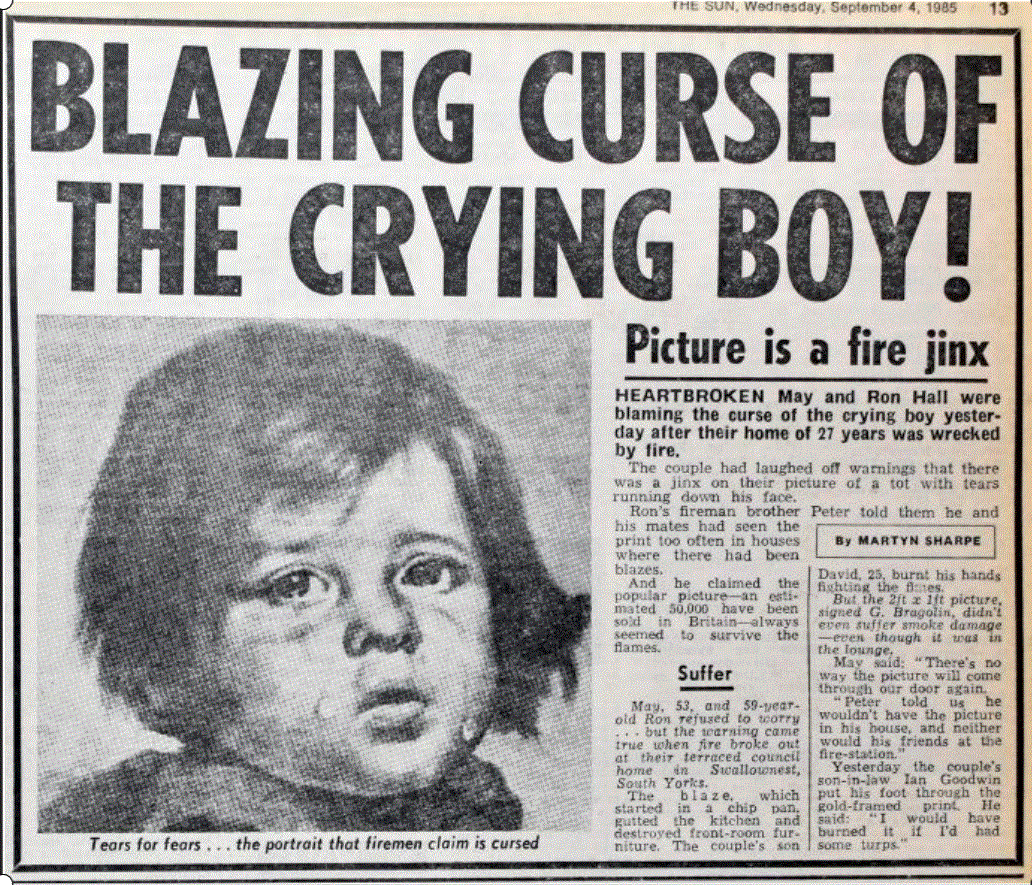Perhaps a lesser-known facet of the paranormal is that of cursed objects, and firmly falling into this category is the portrait of The Crying Boy.
This portrait is said to have been linked to numerous house fires with the particularly eerie element that the picture remains unharmed, often still hanging on the wall while all around is destroyed.

The story suddenly emerged in The Sun newspaper on 4 September 1985 headlined "Blazing Curse of the Crying Boy" after a chip-pan fire at Ron and May Hall's Rotherham home.
There's nothing especially newsworthy about that since luckily no one was injured, but Ron Hall's bother Peter - a firefighter - said, “It is well known in the Fire Service that there are plenty of house fires in the UK where the crying boy print was found but left undamaged”. This was the case at the Hall's house - and so the story was born...
Readers were particularly shaken by The Sun claiming, “No firefighters would ever bring a copy of this painting into their own homes”, lending apparent credibility to the curse.

The next day The Sun ran a follow-up story reporting that many readers had contacted the newspaper also claiming to be victims of the Crying Boy curse. A week later the paper published “Crying Boy Curse Strikes Again” in which another family posed next to their burnt-out home clutching an undamaged picture of a crying boy.
As reports came in, a familiar pattern emerged; that of homes being destroyed, but the print and frame left barely scorched. What helped fuel the narrative was the apparent obscurity of the artist who had various pseudonyms but was eventually identified as the Spanish painter Bruno Amadio, who died in 1981.

There also appears to be a murky backstory to the crying model in the painting, said by some to be a Spanish boy called Don Bonillo, who accidentally started a fire in which his parents died. There is the suggestion that he was adopted against his will by a priest, or even that he was abused by the artist.
Another version claims that he had set fire to an artist’s studio, ran off crying never to be seen again. It's been claimed that Bonillo died in a dreadful car accident when he was burnt to death in 1976. None of this has been verified, but if so could it be relevant to the story?
It seems many thousands of these prints were sold in the UK from the 1950s onwards and it was soon revealed that several different versions of the boy were associated with these house fires, some painted by Amadio but by no means all.

At the height of the story South Yorkshire Fire Brigade released a statement in order to quell growing fears: “A large number of these pictures have been imported into Britain. Any connection with the fires is purely coincidental. Fires are not started by pictures or coincidence," stated Chief Divisional Officer Mick Riley, "but by careless acts and omissions. The reason why this picture has not always been destroyed in the fire is because it is printed on high density hardboard, which is very difficult to ignite.” These rational explanations were ignored by The Sun which claimed: “Fire chiefs have admitted they have no logical explanation for a number of recent incidents”.
Following a case where another crying boy had survived a serious restaurant fire in Great Yarmouth, The Sun invited concerned readers to send in their crying boy prints to rid themselves of this dangerous curse.
This publicity stunt was extremely successful. According to Kelvin MacKenzie, The Sun’s editor at the time, the office “got swamped in crying boy pictures,” and he refused to have the paintings in the office. The paper decided to publicly destroy over 2,500 in a dramatic Halloween bonfire on the banks of the River Thames near Reading, which at least proved that they would actually burn.

Fire officer, Barry Davis who was present said – probably with tongue in cheek: “I think there will be many people who can breathe a little easier now.” The paper then published their final article on the matter titled "Crying Flame" - featuring Sun Page 3 girl Jane Moore - announcing the curse had been lifted.
Professor Purkiss, an Oxford University folklore researcher said of the story: “People aren’t very rational, especially when unexpected disaster strikes. It’s actually far more comforting to believe that your house burned down because of a cursed picture than to believe it was simply a random act of chance, or to blame yourself for not turning the stove off under the chip pan."
She added: “If the cursed picture caused the fire, not only are you not responsible, but you are also significantly more interesting than if you simply left some fat on the stove.”
Cultural historian Gail-Nina Anderson observed: “The crying boy legend grew quickly because everyone could participate - the paintings were cheap and easy to find. The Crying Boy painting legend became so widespread that it grew to include all versions of similar paintings by various artists, including ‘cursed’ paintings of crying girls”.
Having dug into this case I think it gives a fascinating insight into the creation and growth of a modern legend. It reveals the relationship between the media and public and how such stories develop. It shows how people wish to maintain their beliefs despite compelling arguments against them.
But it’s still a mystery to me why anyone would chose to have such a mawkish, melancholy print of a child in their homes in the first place…
Links:
